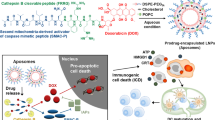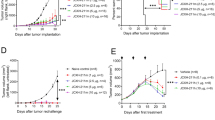ABSTRACT
Purpose
In vivo application of siRNA/PEGylated cationic liposome complex (lipoplex) is impeded by two main obstacles: cytokine responses and anti-PEG IgM responses to PEGylated siRNA-lipoplex. Here, we investigated whether co-administration of oxaliplatin (l-OHP) abrogates the cytokine release and anti-PEG IgM production by PEGylated siRNA-lipoplex.
Methods
Free l-OHP was administered either simultaneously or 30 min prior to PEGylated siRNA-lipoplex administration, and cytokine response and anti-PEG IgM production were evaluated. In addition, the effect of the liposomal encapsulation of l-OHP on the immunogenic response of PEGylated siRNA-lipoplex was investigated.
Results
Simultaneous co-administration of free l-OHP with PEGylated siRNA-lipoplex caused a significant reduction in anti-PEG IgM production, along with an increase in the cytokine response. Free l-OHP injected prior to the lipoplex injection, however, successfully reduced cytokine release and anti-PEG IgM response. Platination of siRNA by simultaneously administered free l-OHP might facilitate the dissociation of double-stranded siRNA to single-stranded siRNA, resulting in the inducement of a potent immuno-stimulation of siRNA via endosomal toll-like receptors (TLRs). On the other hand, encapsulation of l-OHP into the siRNA-lipoplex resulted in a reduction of both anti-PEG IgM production and cytokine responses.
Conclusions
Our results suggest that, besides the expected therapeutic efficacy of co-administration, encapsulation of l-OHP into the PEGylated siRNA-lipoplex has great potential for minimizing the immunostimulation of PEGylated siRNA-lipoplex, resulting in a safe, applicable, and compliant treatment regimen for sequential clinical administration.





Similar content being viewed by others
Abbreviations
- ABC:
-
Accelerated blood clearance
- CHOL:
-
Cholesterol
- DC-6-14 O,O’:
-
O,O’- ditetradecanoyl-N- (α-trimethylammonio acetyl) diethanolamine chloride
- DOPE:
-
Dioleoylphospatidyl-ethanolamine
- HRP:
-
Horseradish peroxidase
- HSPC:
-
Hydrogenated soy phosphatidyl choline
- IL-6:
-
Interleukin 6
- IFN-γ:
-
Interferon gamma
- l-OHP:
-
Oxaliplatin
- mPEG2000-DSPE:
-
2-distearoyl-sn-glycero-3-phosphoethanolamine-n-[methoxy (polyethylene glycol)-2000
- NF-κB:
-
Nuclear factor kappa B
- POPC:
-
1-1-palmitoyl-2-oleoyl-sn-glycero-3-phosphocholine
- RNAi:
-
RNA interference
- siCL:
-
siRNA-lipoplex
- siRNA:
-
Short interfering RNA
- ssiRNA:
-
Single stranded siRNA
- TLRs:
-
Toll like receptors (TLRs)
- Tm:
-
Thermal melting
- TNF-α:
-
Tumor necrosis factor alpha
REFERENCES
Sibley CR, Seow Y, Wood MJ. Novel RNA-based strategies for therapeutic gene silencing. Mol Ther. 2010;18(3):466–76.
McManus MT, Sharp PA. Gene silencing in mammals by small interfering RNAs. Nat Rev Genet. 2002;3(10):737–47.
Bernstein E, Denli AM, Hannon GJ. The rest is silence. RNA. 2001;7(11):1509–21.
Dykxhoorn DM, Novina CD, Sharp PA. Killing the messenger: short RNAs that silence gene expression. Nat Rev Mol Cell Biol. 2003;4(6):457–67.
Aliabadi HM, Landry B, Sun C, Tang T, Uludag H. Supramolecular assemblies in functional siRNA delivery: where do we stand? Biomaterials. 2012;33(8):2546–69.
Singha K, Namgung R, Kim WJ. Polymers in small-interfering RNA delivery. Nucleic Acid Ther. 2011;21(3):133–47.
Aagaard L, Rossi JJ. RNAi therapeutics: principles, prospects and challenges. Adv Drug Deliv Rev. 2007;59(2–3):75–86.
Devi GR. siRNA-based approaches in cancer therapy. Cancer Gene Ther. 2006;13(9):819–29.
Wu SY, McMillan NA. Lipidic systems for in vivo siRNA delivery. AAPS J. 2009;11(4):639–52.
Cattel L, Ceruti M, Dosio F. From conventional to stealth liposomes: a new Frontier in cancer chemotherapy. J Chemother. 2004;16 Suppl 4:94–7.
Symon Z, Peyser A, Tzemach D, Lyass O, Sucher E, Shezen E, et al. Selective delivery of doxorubicin to patients with breast carcinoma metastases by stealth liposomes. Cancer. 1999;86(1):72–8.
Roux E, Passirani C, Scheffold S, Benoit JP, Leroux JC. Serum-stable and long-circulating, PEGylated, pH-sensitive liposomes. J Contr Release. 2004;94(2–3):447–51.
Judge AD, Sood V, Shaw JR, Fang D, McClintock K, MacLachlan I. Sequence-dependent stimulation of the mammalian innate immune response by synthetic siRNA. Nat Biotechnol. 2005;23(4):457–62.
Heil F, Hemmi H, Hochrein H, Ampenberger F, Kirschning C, Akira S, et al. Species-specific recognition of single-stranded RNA via toll-like receptor 7 and 8. Science. 2004;303(5663):1526–9.
Lampson GP, Tytell AA, Field AK, Nemes MM, Hilleman MR. Inducers of interferon and host resistance. I. Double-stranded RNA from extracts of Penicillium funiculosum. Proc Natl Acad Sci U S A. 1967;58(2):782–9.
Williams BR. Signal integration via PKR. Sci STKE. 2001;2001(89):re2.
Robbins M, Judge A, MacLachlan I. siRNA and innate immunity. Oligonucleotides. 2009;19(2):89–102.
Ishida T, Kiwada H. Accelerated blood clearance (ABC) phenomenon upon repeated injection of PEGylated liposomes. Int J Pharm. 2008;354(1–2):56–62.
Dams ET, Laverman P, Oyen WJ, Storm G, Scherphof GL, van Der Meer JW, et al. Accelerated blood clearance and altered biodistribution of repeated injections of sterically stabilized liposomes. J Pharmacol Exp Ther. 2000;292(3):1071–9.
Ishida T, Ichihara M, Wang X, Yamamoto K, Kimura J, Majima E, et al. Injection of PEGylated liposomes in rats elicits PEG-specific IgM, which is responsible for rapid elimination of a second dose of PEGylated liposomes. J Contr Release. 2006;112(1):15–25.
Saad M, Garbuzenko OB, Minko T. Co-delivery of siRNA and an anticancer drug for treatment of multidrug-resistant cancer. Nanomed (Lond). 2008;3(6):761–76.
Ishida T, Atobe K, Wang X, Kiwada H. Accelerated blood clearance of PEGylated liposomes upon repeated injections: effect of doxorubicin-encapsulation and high-dose first injection. J Contr Release. 2006;115(3):251–8.
Cui J, Li C, Wang C, Li Y, Zhang L, Yang H. Repeated injection of pegylated liposomal antitumour drugs induces the disappearance of the rapid distribution phase. J Pharm Pharmacol. 2008;60(12):1651–7.
Ishida T, Wang X, Shimizu T, Nawata K, Kiwada H. PEGylated liposomes elicit an anti-PEG IgM response in a T cell-independent manner. J Contr Release. 2007;122(3):349–55.
Bartlett GR. Phosphorus assay in column chromatography. J Biol Chem. 1959;234(3):466–8.
Tagami T, Nakamura K, Shimizu T, Ishida T, Kiwada H. Effect of siRNA in PEG-coated siRNA-lipoplex on anti-PEG IgM production. J Contr Release. 2009;137(3):234–40.
Hedman HK, Kirpekar F, Elmroth SK. Platinum interference with siRNA non-seed regions fine-tunes silencing capacity. J Am Chem Soc. 2011;133(31):11977–84.
Tagami T, Uehara Y, Moriyoshi N, Ishida T, Kiwada H. Anti-PEG IgM production by siRNA encapsulated in a PEGylated lipid nanocarrier is dependent on the sequence of the siRNA. J Contr Release. 2011;151(2):149–54.
Hornung V, Guenthner-Biller M, Bourquin C, Ablasser A, Schlee M, Uematsu S, et al. Sequence-specific potent induction of IFN-alpha by short interfering RNA in plasmacytoid dendritic cells through TLR7. Nat Med. 2005;11(3):263–70.
Klinman DM, Yi AK, Beaucage SL, Conover J, Krieg AM. CpG motifs present in bacteria DNA rapidly induce lymphocytes to secrete interleukin 6, interleukin 12, and interferon gamma. Proc Natl Acad Sci U S A. 1996;93(7):2879–83.
Hemmi H, Takeuchi O, Kawai T, Kaisho T, Sato S, Sanjo H, et al. A toll-like receptor recognizes bacterial DNA. Nature. 2000;408(6813):740–5.
Tel J, Hato SV, Torensma R, Buschow SI, Figdor CG, Lesterhuis WJ, et al. The chemotherapeutic drug oxaliplatin differentially affects blood DC function dependent on environmental cues. Cancer Immunol Immunother. 2012;61(7):1101–11.
Cavaillon JM. Cytokines and macrophages. Biomed Pharmacother. 1994;48(10):445–53.
Gordon S, Martinez FO. Alternative activation of macrophages: mechanism and functions. Immunity. 2010;32(5):593–604.
Kasparkova J, Vojtiskova M, Natile G, Brabec V. Unique properties of DNA interstrand cross-links of antitumor oxaliplatin and the effect of chirality of the carrier ligand. Chem. 2008;14(4):1330–41.
Sioud M. Induction of inflammatory cytokines and interferon responses by double-stranded and single-stranded siRNAs is sequence-dependent and requires endosomal localization. J Mol Biol. 2005;348(5):1079–90.
Girart MV, Fuertes MB, Domaica CI, Rossi LE, Zwirner NW. Engagement of TLR3, TLR7, and NKG2D regulate IFN-gamma secretion but not NKG2D-mediated cytotoxicity by human NK cells stimulated with suboptimal doses of IL-12. J Immunol. 2007;179(6):3472–9.
Laverman P, Carstens MG, Boerman OC, Dams ET, Oyen WJ, van Rooijen N, et al. Factors affecting the accelerated blood clearance of polyethylene glycol-liposomes upon repeated injection. J Pharmacol Exp Ther. 2001;298(2):607–12.
Immordino ML, Dosio F, Cattel L. Stealth liposomes: review of the basic science, rationale, and clinical applications, existing and potential. Int J Nanomed. 2006;1(3):297–315.
Kato T, Natsume A, Toda H, Iwamizu H, Sugita T, Hachisu R, et al. Efficient delivery of liposome-mediated MGMT-siRNA reinforces the cytotoxity of temozolomide in GBM-initiating cells. Gene Ther. 2010;17(11):1363–71.
Nakamura K, Abu Lila AS, Matsunaga M, Doi Y, Ishida T, Kiwada H. A double-modulation strategy in cancer treatment with a chemotherapeutic agent and siRNA. Mol Ther. 2011;19(11):2040–7.
Singh A, Boldin-Adamsky S, Thimmulappa RK, Rath SK, Ashush H, Coulter J, et al. RNAi-mediated silencing of nuclear factor erythroid-2-related factor 2 gene expression in non-small cell lung cancer inhibits tumor growth and increases efficacy of chemotherapy. Cancer Res. 2008;68(19):7975–84.
Acknowledgments and Disclosures
We thank Mr. J.L. McDonald for his helpful advice in preparing this manuscript. This study was supported by the Egyptian government represented in the cultural affairs and missions sector (Ministry of High Education), the Takeda Science Foundation, the Takahashi Industrial and Economic Research Foundation, and a Grant-in-Aid for scientific Research (B) (2339001220).
Author information
Authors and Affiliations
Corresponding author
Rights and permissions
About this article
Cite this article
Alaaeldin, E., Abu Lila, A.S., Moriyoshi, N. et al. The Co-Delivery of Oxaliplatin Abrogates the Immunogenic Response to PEGylated siRNA-Lipoplex. Pharm Res 30, 2344–2354 (2013). https://doi.org/10.1007/s11095-013-1078-4
Received:
Accepted:
Published:
Issue Date:
DOI: https://doi.org/10.1007/s11095-013-1078-4




